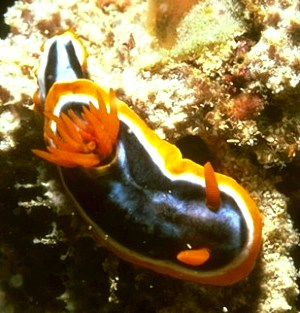
Chromodoris cf. africana
Rudman, 1982
Order: NUDIBRANCHIA
Suborder: DORIDINA
Family: Chromodorididae
DISTRIBUTION
eastern Indian Ocean, western Pacific.
PHOTO
UPPER RIGHT: Surf Pt, Shark Bay, Western Australia [WAM312-85].
LOWER LEFT: Kendrew Is, Dampier Archipelago, Western Australia.
LOWER RIGHT: Surf Pt, Shark Bay, Western Australia, March 1986 [WAM335-85].
PHOTOS: Clay Bryce.
In the eastern Indian Ocean and western Pacific there is a 'species' of Chromodoris, very similar in external colour to Chromodoris africana from the western Indian Ocean. It often has some blue in the background colour and the black bands are often broken and less regular than in C. africana. One other difference seems to be that whereas in C. africana the two inner white longitudinal bands connect with the outer white band at the anterior end, in C. cf. africana the black forms a transverse band anteriorly blocking the white bands inside the black region from joining the outer white band.
The radular teeth have a number of morphological differences from C. africana. In C. africana, the innermost lateral tooth on each side has 3-4 inner denticles and no outer denticles, and the other lateral teeth can have a few small outer denticles, but at the base of the tooth, or none. In comparison, Chromodoris cf. africana the innermost lateral tooth has up to 5 inner and outer denticles, and the other lateral teeth have up to 7 prominent outer denticles.
References:
• Rudman, W.B. (1977) Chromodorid opisthobranch Mollusca from East Africa and the tropical West Pacific. Zoological Journal of the Linnean Society 61: 351-397.
• Rudman, W.B. (1982) The Chromodorididae (Opisthobranchia: Mollusca) of the Indo-West Pacific: Chromodoris quadricolor, C. lineolata and Hypselodoris nigrolineata colour groups.
Zoologica Journal of the Linnean Society, 76: 183-241.
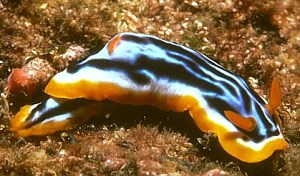
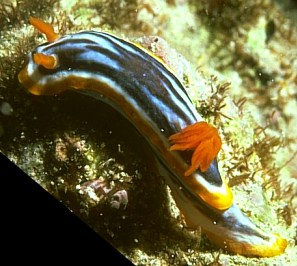
Rudman, W.B., 1999 (July 19) Chromodoris cf. africana Rudman, 1982. [In] Sea Slug Forum. Australian Museum, Sydney. Available from http://www.seaslugforum.net/find/chrocfaf
Related messages
Re: Chromodoris hamiltoni ? from India
May 6, 2010
From: Franco De Lorenzi
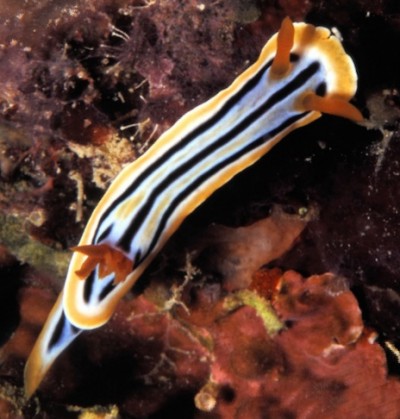
Concerning message #23138:
Dear prof. Rudman reading this message I looked at a photo I have of this species but, at first I thought it might be C. hamiltoni, now I wonder if it is Chromodoris colemani or Chromodoris cf. colemani.
In effect there is not much orange background on it.
Locality: Cebu, 18 Metres, Philippines, indopacific ocean, august 2005, coral. Length: 25 mm. Photographer: Franco De Lorenzi.
Thanks for help.
Franco
cratena@tiscali.it
De Lorenzi, F., 2010 (May 6) Re: Chromodoris hamiltoni ? from India. [Message in] Sea Slug Forum. Australian Museum, Sydney. Available from http://www.seaslugforum.net/find/23619Dear Franco,
This is a very good example illustrating the difficulties we still have in distinguishing some of these species with longitudinal black lines. Your animal certainly looks like some specimens of C. hamiltoni in having the secondary brown lines, but in that species the orange border goes right to the mantle edge, wherEas in your animal there is a clear white band right at the edge.
One common west Pacific species with a submarginal orange band like this is C. magnifica, which seems to quite variable in the number and type of black lines it has, but in that species the mantle skirt is very wide whereas your animal belongs to a group of species with relatively narrow sides to the mantle. At the moment I have been putting animals with your colour pattern in a group I have called Chromodoris cf. africana, but some of those have the orange border right at the edge, so there is probably more than one species mixed up in this lot as well.
Sorry I can't be more help but this is definitely a group in need of more work. Unfortunately I don't think anatomical differences are going to be distinct enough to provide resolution. Some will say that DNA studies will resolve it, wich may be so, but I suspect what is really needed is some good field workers who can study these animals as populations. Most of our information at the moment is from a relatively few animals collected on short field trips and random photos taken by interested divers. While all this is valuable, as you can see from my comments, we seem to have reached a plateau where we can recognise problems rather than solving them.
Best wishes,
Bill Rudman
Chromodoris cf. africana from Madagascar [1]
February 13, 2009
From: Sully et Monika Bachel
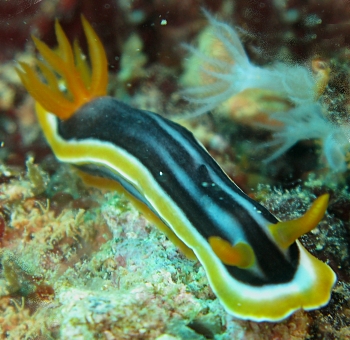

Concerning message #20981:
Hallo Bill
This is probably a Chromodoris cf. africana observed at the spot "sec de Lakana" on "Ile Ste Marie" on the East coast of Madagascar.
Locality: Ile Ste Marie, 28 m, Madagascar, Indian Ocean, October 2008. Length: 30 mm. Photographer: Sully Bachel.
My wife and I have observed different forms of this nudibranch on this island
best regards
Sully
s.bachel@orange.fr
Bachel, S., 2009 (Feb 13) Chromodoris cf. africana from Madagascar [1]. [Message in] Sea Slug Forum. Australian Museum, Sydney. Available from http://www.seaslugforum.net/find/22234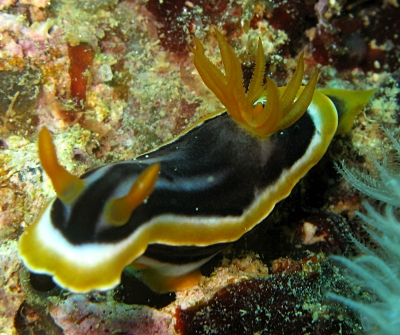
.Dear Sully & Monika,
Yes this is what I am calling Chromodoris cf. africana, but it is possible there is more than one species involved. It is also possible that it is not related to C. africana at all. All I can say is that externally, it looks quite like C. africana.
Best wishes,
Bill Rudman
Re: Chromodoris elisabethina from Indian Ocean?
January 29, 2009
From: Sylvain Le Bris
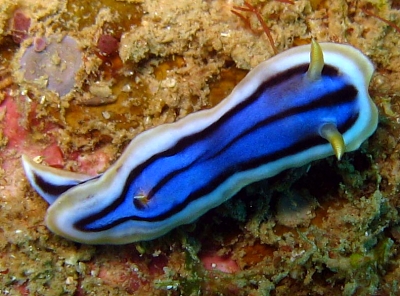
Concerning message #21646:
Hi Bill,
I am not sure but do you think this is Chromodoris elisabethina?
Locality: Nurserie, 15 m, Mayotte, Indian Ocean, 03 December 2008. Length: 2.5 cm. Photographer: Sylvain Le Bris.
Best regards
Sylvain Le Bris
lebris.sylvain@gmail.com
Le Bris, S., 2009 (Jan 29) Re: Chromodoris elisabethina from Indian Ocean?. [Message in] Sea Slug Forum. Australian Museum, Sydney. Available from http://www.seaslugforum.net/find/22200Dear Sylvain,
Every now and then we find an animal which doesn't fit well into any of the many black-lined chromodorids. It looks quite like the West Pacific C. elisabethina and the Indian Ocean C. hamiltoni and C. quadricolor but the wide white band separating the orange border from the inner black line is unusual. At present I have been calling some of these puzzling forms Chromodoris cf. africana but only as a stop-gap measure until we can make better sense of them. One problem is that in most of these species, juveniles can have quite a wide white band as in your animal.
C. elisabethina seems to be restricted to the western Pacific, but we do have specimens from the eastern Indian Ocean [see John Hicks' animal from Christmas Island #6583]. See also Colin Ogden's message #20568 showing the great variability in C. hamiltoni.
Best wishes,
Bill Rudman
Chromodoris cf africana & C. cf. strigata from Exmouth
April 4, 2008
From: Bruce Potter
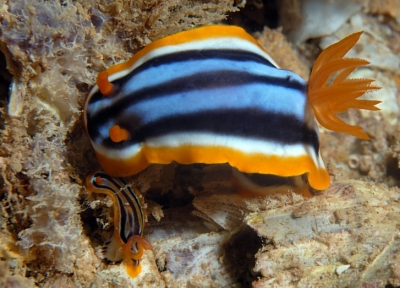
Dear Bill,
Here is another of the blue black and orange Chromodorids from the Exmouth Navy Pier.
Locality: Exmouth, 10 - 12 metres, Western Australia, Indian Ocean, 5 October 2007, under a jetty. Length: 35mm. Photographer: Bruce Potter.
I think this might be Chromodoris africana but I am not at all convinced I have it right. [see also messages #20980, #20982,#20983,#20984 ].
Regards
Bruce Potter.
bandppotter@bigpond.com
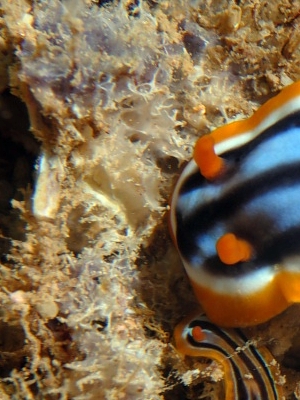
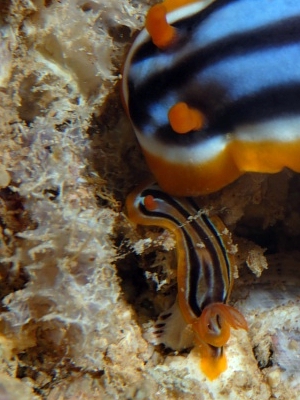
Dear Bruce,
I think you have two different species here. The large animal is what I am calling Chromodoris cf. africana and I am pretty sure the small animal is Chromodoris cf. strigata. Unfortunately that means you haven't a 'real' name for either of them, but it is a useful bit of information to help sort them out.
Of particular interest is that both these animals seem to be feeding - or showing great interest - in the bluish-grey sponge they have their heads on, which I am pretty sure is a dysideid. Interestingly this is an unusual choice for a species of Chromodoris but we already have a record C. cf. strigata [message #18512] feeding on a similar dysideid.
Best wishes,
Bill Rudman
Chromodoris cf. africana from Exmouth, Western Australia
April 4, 2008
From: Bruce Potter
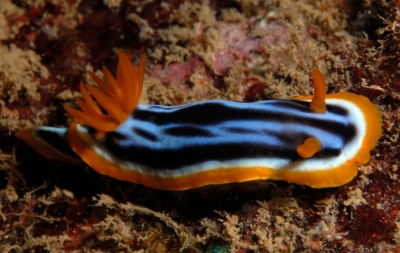
Dear Bill,
I recently dived the Navy Pier at Exmouth. This site has been unavailable to the public for some time, but has just recently been made accessible again. It is a truly phenomenal dive site.
A school of Grey Nurse sharks has recently moved in there. There were masses of Nudi's amongst lots of other stuff. I came away with quite a few chromodorids of similar colour and found myself uncertain of the identity of a few. I will send you 4 or 5 separate messages to try and confirm the identity of them all. [#20981, #20982,#20983,#20984 ]
Locality: Exmouth, 10 - 12 metres, Western Australia, Indian Ocean, 5 October 2007, Rubble under Jetty. Length: 35 mm. Photographer: Bruce Potter.
The first one I am fairly certain is Chromodoris strigata. There were lots of these. They are all in about 10 - 12 metres depth.
Regards
Bruce Potter
bandppotter@bigpond.com
Potter, B., 2008 (Apr 4) Chromodoris cf. africana from Exmouth, Western Australia. [Message in] Sea Slug Forum. Australian Museum, Sydney. Available from http://www.seaslugforum.net/find/20980
Dear Bruce,
I'll do your series of messages together. They are an interesting insight into this group of similarly coloured animals. I can't give a complete answer to them all I am afraid, we still have things to learn. If you regularly visit this spot and your 'to do' list still has a gap in it, it would be nice to know who mates with whom, which sponges they eat and what their egg ribbons look like.
This animal is not C. strigata. In that species there is a distinct pattern of uncolored, translucent patches on the mantle which look very dark grey in photos. Your animals are what I am calling Chromodoris cf. africana. They look somewhat similar to C. africana from the western Indian Ocean but I suspect the similarity is superficial. Most examples of this 'species' are from Western Australia.
Best wishes,
Bill Rudman
Chromodoris sp from Philippines
July 11, 2007
From: Sylvain Le Bris
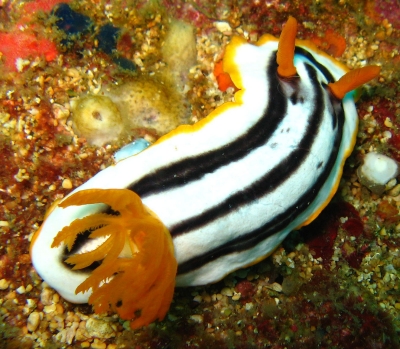
Dear Bill
Is it possible that this nudibranch is a color variation of Chromodoris magnifica?
The orange band is marginal and not submarginal like in C. magnifica.
Locality: Sindigan wall, Sabag, 25m, North Mindoro, Philippines, South China Sea, April 2007. Length: 6cm. Photographer: Sylvain Le Bris.
Sylvain Le Bris
sylvain.lebris@freesbee.fr
Le Bris, S., 2007 (Jul 11) Chromodoris sp from Philippines. [Message in] Sea Slug Forum. Australian Museum, Sydney. Available from http://www.seaslugforum.net/find/20072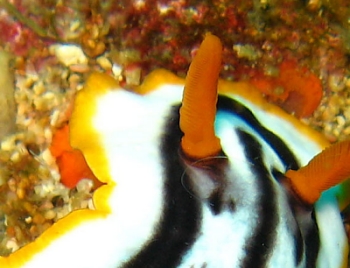
Dear Sylvain,
No this isn't C. magnifica. There are still a few puzzles amongst the black-lined chomodorids and I think this is one I am calling Chromodoris cf. africana. I can't even be sure all the animals I have put on this pages are the same but I find it a useful start to try putting 'look-alikes' together. Normally I do this privately and make many changes before I come up with a workable hypothesis which is worth testing, but the Forum forces me to make my mistakes very publicly. So just remember not everything I say may stand the test of time - or the test of more evidence.
What is quite interesting in your photo is the bright red sponge your chromodorid has its head on. Have you any more photos of this animal which may show the sponge in greater detail - or may show the chromodorid feeding perhaps?
Best wishes,
Bill Rudman
Chromodoris elisabethina? from the Philippines
June 27, 2001
From: Erwin Köhler
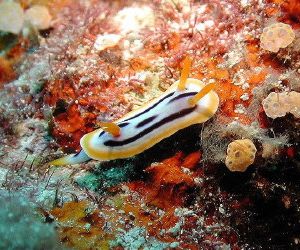
Dear Bill,
Here is the next one from the Philippines, Cebu Island, Moalboal, divesite "Kasay Wall", depth 7 m, length 18 mm, May 29, 2001.
Erwin
Erwin@medslugs.de
Köhler, E., 2001 (Jun 27) Chromodoris elisabethina? from the Philippines. [Message in] Sea Slug Forum. Australian Museum, Sydney. Available from http://www.seaslugforum.net/find/4592Dear Erwin,
I think this is what I am calling Chromodoris cf. africana at the moment. It is paler in background colour but think that is because it is a juvenile
Cheers,
Bill Rudman
Chromodoris cf. africana from Sulawesi
January 27, 2001
From: Lindsay Warren
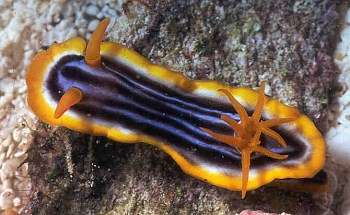
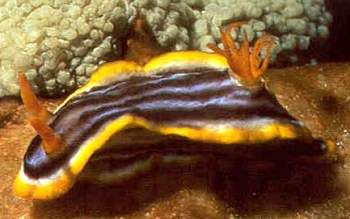
Dear Bill
I found this Chromodoris in the late afternoon on 22 May 1999 at a depth of 15 ft feeding on a brown cylindrical sponge in small alcove in a wall off Pulau Hoga, [Tukang Besi Archipelago, SE Sulawesi, Indonesia - Operation
Wallacea]. Size: approximately 30 mm.
I initially thought it might be C. kuiteri with narrower black bands on the notum but feel that this is probably incorrect. I don't think it is a C. magnifica (but no white edge to the mantle). Could it be C. quadricolor?
All the best
Lindsay Warren
alldcl@compuserve.com
Warren, L., 2001 (Jan 27) Chromodoris cf. africana from Sulawesi. [Message in] Sea Slug Forum. Australian Museum, Sydney. Available from http://www.seaslugforum.net/find/2192Dear Lindsay,
You moved in all the right directions but I am still uncertain about this species. It certainly has similarities to the species you mention and also to C. quadricolor which I recently included on the Forum.
Best wishes,
Bill Rudman.
Chromodoris cf. africana from South Africa
January 27, 2000
From: Valda Fraser
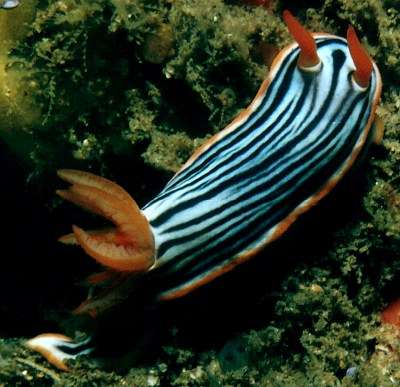
This is a part of Valda Fraser's message about Chromodoris africana and similarly coloured species from South Africa. I have copied it here for cross-reference ... Bill Rudman
Dear Bill
These black and white nudibranchs are confusing me. ... [This one] is Chromodoris cf. africana.
South Coast, KwaZulu-Natal, South Africa.
Hibberdene, June 1999. 50mm
Regards
Valda Fraser
iti04937@mweb.co.za
Fraser, V., 2000 (Jan 27) Chromodoris cf. africana from South Africa. [Message in] Sea Slug Forum. Australian Museum, Sydney. Available from http://www.seaslugforum.net/find/1793Dear Valda,
I'll put this 'species' on the Chromodoris cf. africana page but I think it may be different. It also has similarities in colour to C. striatella and C. lineolata, but in those species the gills and rhinophores have translucent spotting. I would need to look at its anatomy before I could say anything sensible about its relationships to these other species.
Best wishes,
Bill Rudman.
Chromodoris cf. africana from Okinawa?
July 19, 1999
From: Bob Bolland
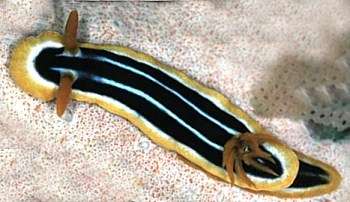
Hi Bill:
I was recently taking a look at some of the striped Chromodoris spp. found here and found the attached JPEG. It seems to fit the description for Chromodoris africana which you provided in the Chromodorididae paper of 1982. I don't have access to your earlier 1977 paper describing animals from East Africa, is this indeed C. africana?
The animal's notum was 35mm, collected from Seragaki, Okinawa on 18 July, 1992.
Cheers,
Bob.
bolland@imicom.or.jp
Bolland, R.F., 1999 (Jul 19) Chromodoris cf. africana from Okinawa?. [Message in] Sea Slug Forum. Australian Museum, Sydney. Available from http://www.seaslugforum.net/find/1059Dear Bob,
I have posted a page on Chromodoris africana so you can compare the differences. You will also see some other animals (C. cf. africana) from Western Australia which may be the same as yours but have anatomical differences to C. africana.
I think we can say the jury is still out on this group of chromodorids. I'll post pictures of two other western Indian Ocean species, C. quadricolor and C. hamiltoni when I get a chance.
Best wishes,
Bill Rudman.
